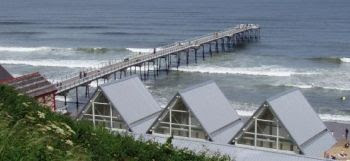It's time to wish a very HAPPY BIRTHDAY to Saltburns Cliff Lift, the oldest of its type in the world still in operation. I will be working with the guys at the lift this month on a great display. Documents recently acquired by Kirkleatham Museum will be available to view for the first time. As to the exact date when the lift became operational, well, that's a bit of a mystery at the moment but we're working on it ........The official date to celebrate this fantastic anniversary will hopefully be available soon.
During the Bank Holiday nearly 5,300 visitors used the lift. In times of recession Saltburn really needs to rely on the tourist industry to generate income, which in turn generates jobs.
Many thanks to the wonderful staff at Kirkleatham Museum and the GREAT STAFF at the cliff lift with whom I have had the pleasure of working on this great historical event.
During the Bank Holiday nearly 5,300 visitors used the lift. In times of recession Saltburn really needs to rely on the tourist industry to generate income, which in turn generates jobs.
Many thanks to the wonderful staff at Kirkleatham Museum and the GREAT STAFF at the cliff lift with whom I have had the pleasure of working on this great historical event.














